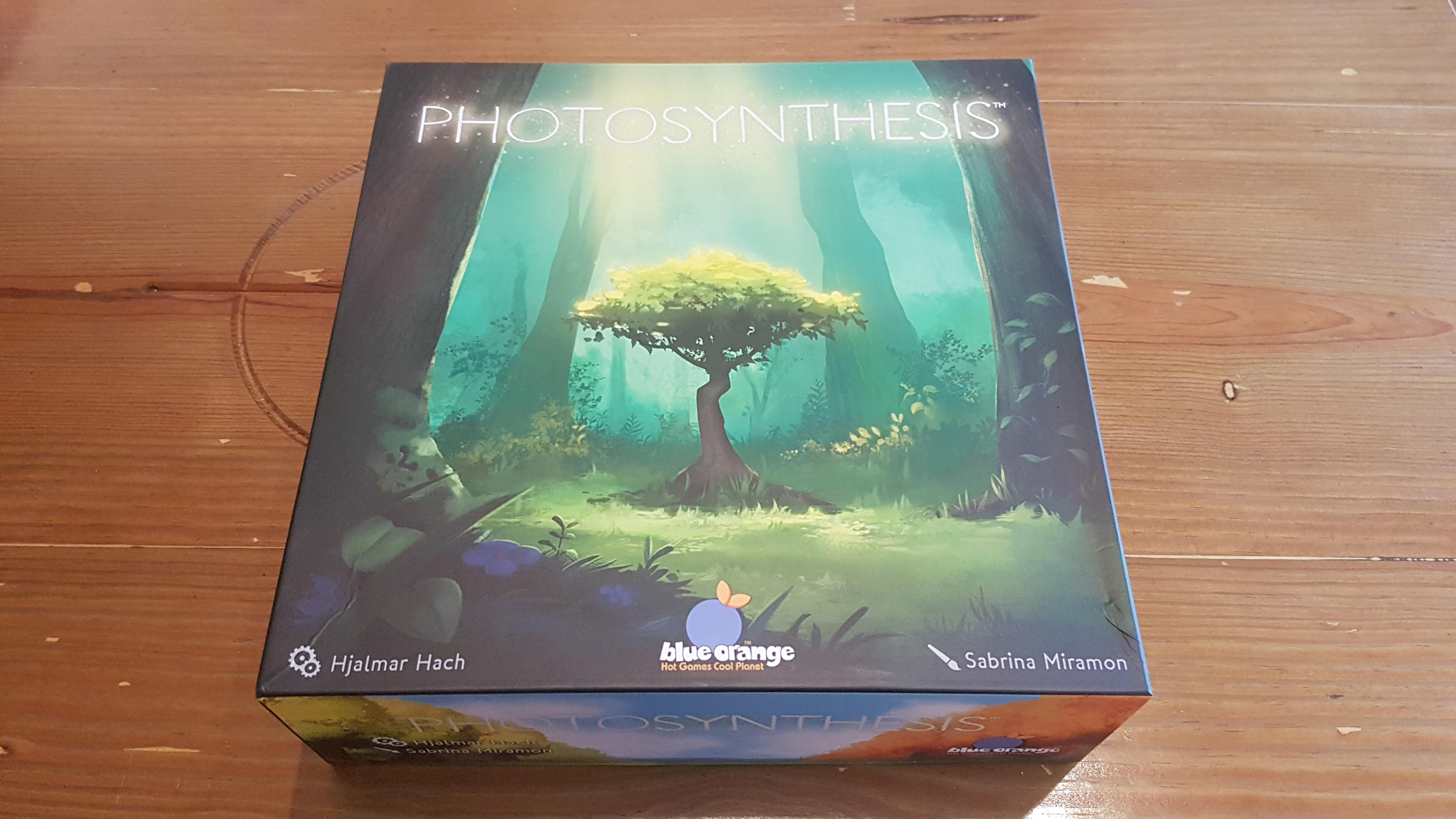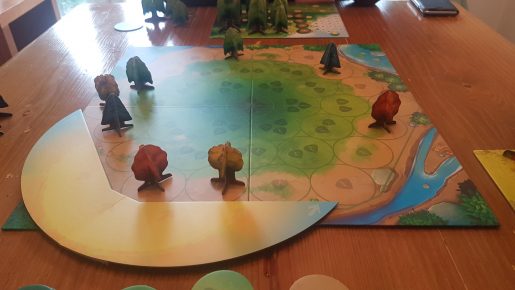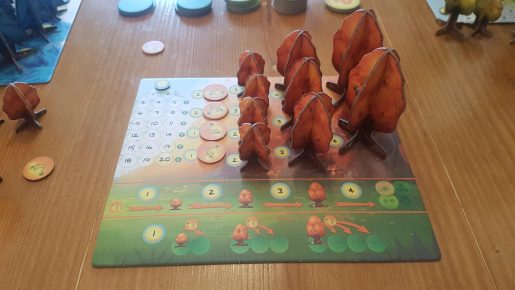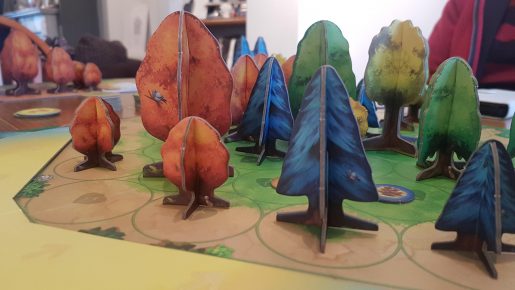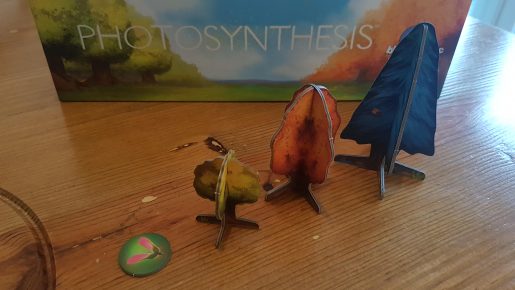Photosynthesis is an abstract strategy game from 2017, published by Blue Orange Games. Designed by Hjalmar Hach, with artwork by Sabrina Miramon, the game sees 2 – 4 players growing trees to bask in sunlight. With trees growing from tiny seeds through to when the trees get chopped down, the whole life of the trees occur, with capturing sunlight and casting shadows along the way. However, is this puzzle a forest you’d want to get lost in? Let’s find out!
A standard game of Photosynthesis is played out over 3 rounds, each consisting of 6 parts, each with two phases. It sounds like a lot but effectively is 18 mini-rounds of collecting light and spending it, with the sun rotating around the board. At the offset of the game each player starts with 4 small trees, 1 medium tree and 2 seeds available to them for placement, alongside a player board full of other seeds and trees to be purchased. Starting the game off each player in turn places a small tree onto the board somewhere at the edge, until everyone has placed 2 trees.
Now the game begins with the first Photosynthesis, or collect, phase. From the sun segment that moves around the board, following the indicated arrows on it, players determine which trees get light. Light points are awarded per tree and based on their size: 1 for small, 2 for medium and 3 for large, with seeds scorings 0. To make this slightly more complex trees also cast a shadow, along the light lines, by the same numbers 1, 2 and 3 spaces for small, medium large trees respectively. Any tree of matching or lower height in a shadow compared to the shadow caster does not score light, so blocking becomes possible. Once light is calculated for each player they add it to their light point tracker on their personal player board and the Life Cycle phase starts.
During this phase players get a single turn but can spend as much, or as little, of their light points as they wish, to perform as many actions as they want. These actions include spending light to: purchase additional seeds or trees, cast out a seed token, grow (upgrade) something on the board or collect a fully-grown tree to gain points. Each tree upgrade increases in cost with a seed to a small tree costing 1 light point while medium to large tree costing 3 light. Note when a component is replaced on the main board it is returned to the players board not the player’s available pool. If no slots are free then it is instead returned to the box. This does happen a little bit; just try to make sure it doesn’t occur too often, or you may limit yourself later on.
Not only do bigger trees get you more light but they also allow the player further reach when it comes to placing a seed. Based on their shadow distance, depending on a tree’s height, is how far away you can place a seed onto the board. So, you’ve spread some seeds and grown some trees to the maximum height. Doing the final stage of the tree process, also the most expensive stage costing 4 light points, the player removes a large tree from the board and takes a scoring token, depending on the ring of the board they are in. The centre space offers the highest return points wise and as a result it and the surrounding ring are often hotly contested.
Once each player has had a turn the next round begins with the sun segment being rotated around the board to shine light from a new direction. The game continues until the sun gets back to the position it started in, at this point a Sun Revolution Counter is returned to the box, the first player marker is passed to the next player and the game resumes. At the end of the third full round the game ends and points are calculated from scoring tokens and an additional point is earnt for each set of 3 remaining light points. Now the player whom has the most points wins and has become one with the trees.
For what is effectively an abstract puzzle game, the theme is remarkably strong. The concept of growing trees, large trees blocking more light and seeds growing to sapling heights and beyond, all make the rules intertwine with theme, making the majority intuitive. Helping the theme flourish are the gorgeous components. The main game board, individual player boards and sun component are robustly designed, with the player boards not only keeping track of light points but also each potential action is listed in illustrations to remind players what they can do. And then, there are the main event… the truly tremendous trees.
Each player has their own styled and coloured set of trees, with a mixture making the board look akin to the stunning colours of Autumn (Fall). With slightly nostalgic twangs from the cardboard trees, harking back to the world renowned (sarcasm) Winnie the Pooh Friends of the Forest Game even putting the trees together, whilst initially time consuming, was enjoyable.
For Photosynthesis the box itself is something to celebrate, due to it being designed with gamers in mind. When games come with so many punch out boards companies often seem to forget gamers will have to fit it all into the box post-punching. This leads to a point of frustration where either components end up rattling around in a huge box or the lid won’t comfortably close flat. For Photosynthesis, everything just fits back in perfectly and the lid closes as if it had all come press assembled. So once constructed they are ready for whenever you play to create a vivid experience that effortlessly grabs the attention of those outside the game.
The trees are also at three very distinct heights making it instantly recognisable how many spaces behind it are covered in shade, the light they earn if not in shadow and how far away seeds can be placed. This makes the board that bit easier to read, despite the forest of cardboard popping up in front of you. The only readability issue is that the two green trees are similar and managed to occasionally confuse players during an initial play. Thankfully this will have ebbed away by the end of a first playthrough, once players no longer had to so intently focus on the mechanics themselves.
While something that isn’t present every time the game hits the table, I have unfortunately encountered a runaway winner situation in Photosynthesis. It became obvious whom the leader was as they started to consistently gain the most gain light, turn after turn. The issue is that if a player gets an early advantage they can get a base engine of small trees up and running to rake in the light points throughout the game. This can be a problem in a 4-player game where it is possible to group up against the leader but is then only exasperated as the player count drops. Either you see your friends starting to resent playing on or you feel any chance of winning had slipped away. It’s not great to experience from either side of the table.
I came out of my initial Photosynthesis experience minutely disappointed. The game simply sends mixed signals. The components, art and design are of a game which should be friendlier than you have to play and the way you have to play cutthroaty to gain an advantage or gang up against the leader feels disjointed from the nature theme. Once past the preconceptions made by the aesthetics, which for production quality can only be praised, Photosynthesis opens up into a rather strategic abstract puzzle that, pardon the pun, grows on you. With the right group, ready to play a bit aggressively, the game will flourish and be firmly rooted to your gaming shelf!
[Editor’s Note: Photosynthesis was provided to us by Blue Orange for review purposes.]

